Welcome to another edition of Willoughby Hills!
This newsletter explores topics like history, culture, work, urbanism, transportation, travel, agriculture, self-sufficiency, and more.
If you like what you’re reading, you can sign up for a free subscription to have this newsletter delivered to your inbox every Wednesday and Sunday and get my latest podcast episodes:
My kids (10 and 7) recently decided that they were ready to clean out some of their baby books from their bookshelves. It was a little bittersweet for me because it meant the kids were growing up.
I built the bookshelves in both of my kids’ rooms. They are simple designs- meant to mimic the functionality of an IKEA Billy bookshelf, but made much sturdier and out of real wood.
I built my daughter’s one first back in 2016 and it was one of the first legit woodworking projects that I tried. My goal in making it was to experiment with proportions- I wanted to think about how the width and height related to one another, how far apart the shelves should be, how far the shelves should be offset from the sides, things like that.
After I built it, I showed a photo of the bookshelf to Tom Silva and pitched it to him as a “Build It” segment on Ask This Old House. Not only did we end up making it for the show, but Tom was able to make his with only two tools.
When we first added the new bookshelf to my daughter’s room, she was three years old and the shelf also had space for stuffed animals and other toys. Over the next few years, the toys moved out and the shelf became overloaded with books.
When I built my son’s bookshelf for his room in 2021, it was nearly full from day one. He had inherited a lot of books from his sister, plus had acquired a bunch of his own.
The truth is, we never set out to collect books for the kids, it just kind of happened. People would give books as gifts, especially in the early years. We soon learned that a book was a more practical souvenir from our travels than a large stuffed animal, a snowglobe or other keepsake, or a sugary treat.
At the end of my daughter’s kindergarten year, the private K-5 school she was attending permanently closed. After the last day of school, they held a “garage sale,” where families enrolled in the school could take anything they wanted for free. We picked up school supplies, two classroom desks, and tons of books. My wife picked out every historic American Girl book that she thought would appeal to my daughter and many, many more. The books and school supplies ended up coming in very handy, as before long, we were stuck at home during a global pandemic and I was serving as a homeschool teacher making do with what we had on hand.
I’ve written before about our library’s annual book sale, where books are priced based on how many bags you fill. We let the kids choose what they want because it feels like a better deal to fill a bag as full as possible rather than just select the two or three books that we know will get read.
In case you haven’t noticed the pattern, most of the books our kids own are second hand. We do occasionally visit Barnes and Noble with them or order one particular title off Amazon, but that is rare. Nearly every book on their shelf is one that was once on somebody else’s shelf.
And even though we sound like book hoarders, the truth is we frequent our local public library and borrow books from there way more often than we purchase new.
Still, it felt like we were drowning in books and it was time to do some cleaning up. My wife spent a weekend with each kid going through their shelf and choosing what should remain in their room, what they might want to box up and save for sentimental reasons, and which books they were ready to discard. After that weekend, we ended up with two large boxes of books that were ready for a new home.
As Sandra Goldmark discussed in her book Fixation and when she was a guest on my podcast, one of the challenges of having so much stuff in our modern world is finding a good home for that which is still useful. I ran into that dilemma here.
Many of the books we had seemed desirable to me. There were Dr. Seuss books, Berenstain Bears books, Disney books, and many others from recognizable authors or famous franchises. They were in pretty good shape and felt like they were worth something.
I could have gone through and listed each one on Amazon or eBay, but that would be a tedious process of typing out information about each one, setting a price, and then shipping each book individually if it were to even sell. For that effort, I may end up netting a dollar per book if I was lucky.
I could donate the books to a local thrift store. Goodwill would certainly take them off of my hands, but I wouldn’t get anything in return. If I took them to Savers, the donation would get me a 20% coupon towards a future purchase, but that didn’t feel like much.
There aren’t many used bookstores near me, but I decided to drive about a half hour to the Used Book Superstore in Burlington, MA. There used to be a few locations under this name in Massachusetts, but the store in Burlington is the lone survivor at this point. They claim to purchase any book from the last 10 years for cash.
I brought my two boxes of books to the sale counter, hoping it would feel like an episode of Antiques Roadshow. I imagined the employee digging through my box, finding a mint condition copy of Fox in Socks, hugging the book close to her as sirens went off and cash fell from the ceiling as though I won a radio contest. That’s not quite what happened.
A woman in her early twenties who could have been a Janeane Garofalo character if this were a 1990s comedy began digging through my box. She would occasionally pull out a book that interested her, scan it into her computer, and place it in one of two piles. Of the dozens of books in my boxes, she pulled out maybe 40 to scan. Of those, maybe 25-30 made the final cut.
In less than 10 minutes, I received my verdict. They were only interested in the 30 or so books that were in the “buy” pile and would be worth $30.50 in store credit for $15.25 in cash. I opted for the cash, as I didn’t need more books. At least, not right then.
As for the remainder of the books I brought in, they were only eligible to be donated. The store accepts donations in exchange for a 15% coupon, so I would receive that as well. I asked her where the donations go and was told that they are sorted again and those which are sellable are placed on the store shelves. Those which are not are shipped to Kenya.
In the brief time I was standing at the sale counter, at least five other people came in with donations. One person brought a huge box, while others had 2-3 books in a bag, seemingly interested in the coupon more than anything else.
I looked into the laundry hamper that held the donation books and was overwhelmed. There were hundreds, perhaps even one thousand books just in that hamper alone. Some looked interesting, but many looked like dated paperbacks.
I wondered who in Kenya had any interest in reading drug store dime novels from the 1970s or 1980s Babysitters Club paperbacks. Was this store sending books to Kenya because there was truly a need for English language books there or was this just a clever way for Americans to outsource our environmental problems on the rest of the world? After all, many of the books I saw (including some of my own) felt like they were ready to be recycled or even sent to a landfill. Perhaps that’s what’s happening when they get to Kenya, much like how our discarded clothes are pile up in the Chilean desert and can now be seen from space.
At any rate, the exercise of recognizing our accumulation of books in our own household combined with seeing how many books my neighbors were discarding on a single random Saturday made me think about our consumption and how we can do better.
As Sandra Goldmark also points out, owning stuff is human. The solution to having too many books is not to stop reading altogether. The solution is to think about how we can be more mindful about the books that we do have.
For me, it means resolving to buy less books and when I do purchase them, to buy them secondhand from places like Used Book Superstore. It also is a good reminder to continue to use our public library.
I am always impressed that libraries exist at all. I like to imagine what would happen if somebody proposed the idea of a library today. Ted Cruz would rail on the Senate floor about “grooming our children” with knowledge, Marco Rubio would oppose spending tax dollars to make people smarter, and Marjorie Taylor Greene would no doubt see it as a plot to turn America socialist.
But libraries are awesome! Books, movies, music, and so much more can be checked out for free. If my particular branch doesn’t have something, it can usually be ordered from another branch and arrive in a few days. I can renew something if I need more time with it. There’s no limit to how much can be checked out a time. And it means I can share a book with dozens of neighbors without us each needing to own a copy.
It’s easy to demonize American consumption vis a vis fast food or fast fashion. It’s harder to make knowledge seem like a bad thing. But as with any consumption, moderation and consciousness are the key. Hopefully the next time I go to sell used books, the box I’m bringing is a little smaller.
Thanks for reading Willoughby Hills! Subscribe for free to receive new posts and support my work.
Related Reading
If you’ve missed past issues of this newsletter, they are available to read here.


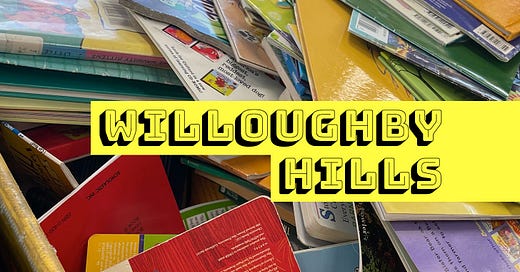



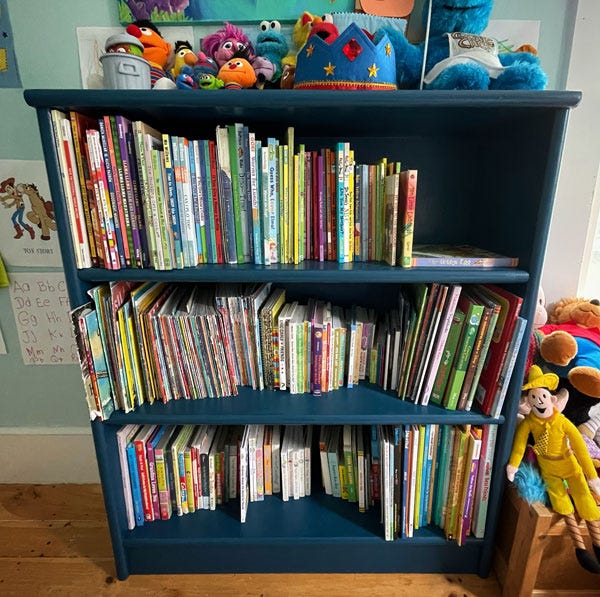
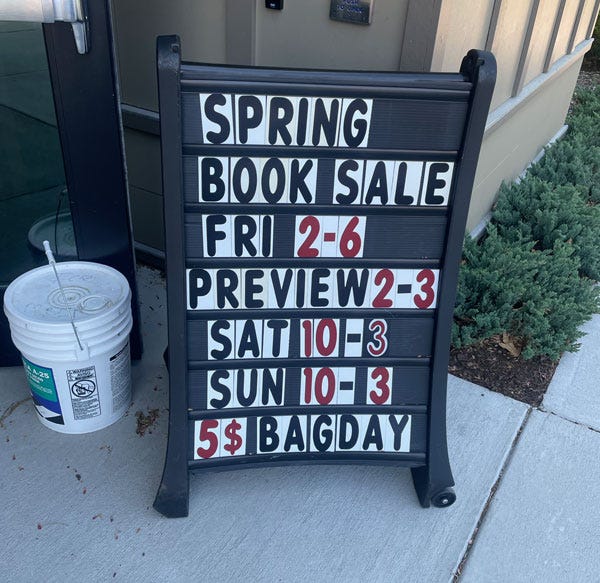
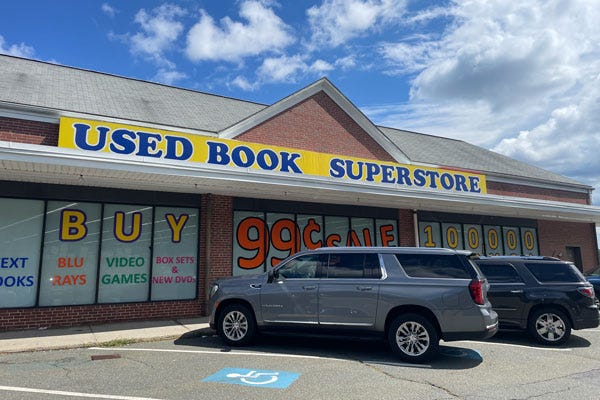
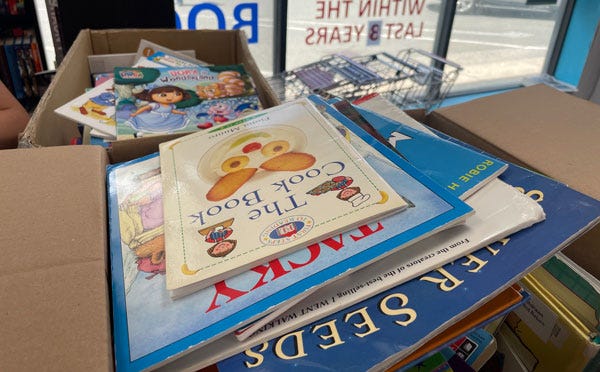
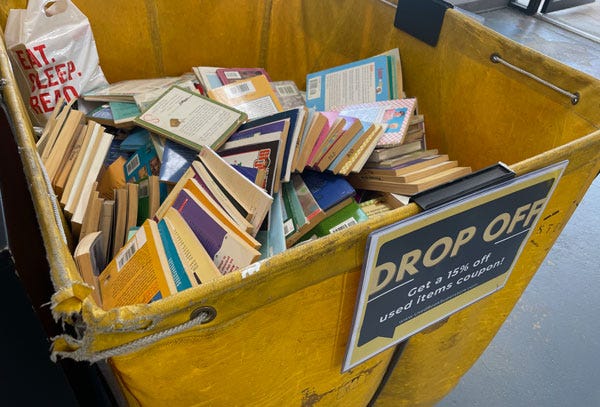
This topic is often discussed at our house...”what to do with the books”? When we moved into this house, we donated boxes of books to library for their book sales. Those were educational, biographical or leather bound classics. (The old people with lots of bookcases who loves to read.) Our small bookcase, tables and floors are full. I can’t hold books now, but my Kindle is full.